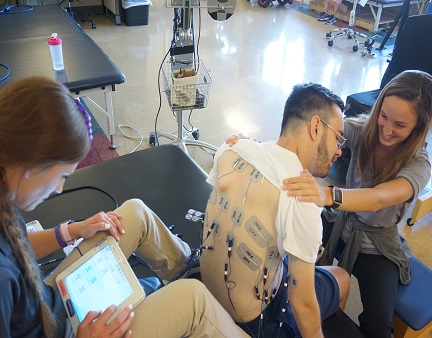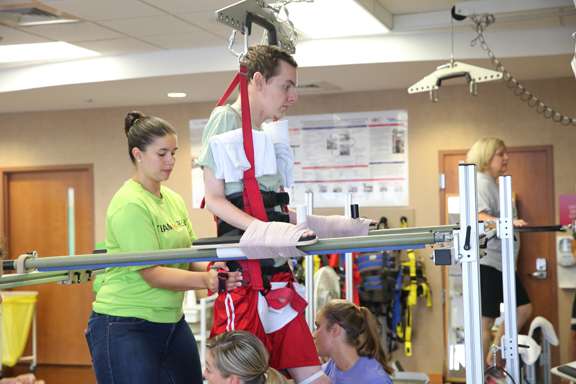|
Bladder and sexual dysfunction consistently ranks as one of the top disorders affecting quality of life after SCI. The insights of how activity-based training affects bladder function may prove to be useful to other patient populations with bladder and sexual dysfunction such as multiple sclerosis, Parkinson’s, and stroke as well as stimulate investigations of training’s effects within other systems such as bowel dysfunction. Step training could help promote functional recovery and any insights gained from these studies will enhance further investigation of the effect of bladder functioning after SCI. In addition, as suggested by a study of one of our initial participants, a reduction in the use and/or dosage of medication to enhance sexual function is a possible outcome, medications which carry risks and side effects.
The study will be explained to you fully by study personnel. Once you sign the consent form, study personnel will communicate with you to schedule your appointments. You will then undergo a physical examination by the study doctor.
Also we will collect some basic information, blood pressure, heart rate, and oxygen levels The following evaluations will be completed before and after your 80 session training intervention (unless otherwise noted).
Evaluations
- Voiding diary- We will ask you to keep a diary of your voiding (or catheterization) for two consecutive 24 hour periods per week. We will also be taking and testing a urine sample from you once a week.
- Urodynamics- You will go to the ULP Urology Clinic to have this procedure done by Dr. Messer. You will be asked to sign a separate consent form for this procedure. We will first take a measurement of your urinary flow. Then we will take a measure of the pressure inside your bladder. This will involve draining your bladder completely and filling it with water using a special catheter that can measure the internal pressure. While this is done another catheter will be placed in your rectum; also to measure pressure. You will then be asked to empty your bladder while we measure the pressures. While the pressures are being recorded, we will insert EMG needle wires electrodes around your urethra to measure its activity. We will apply topical pain dulling cream before insertion. EMG electrodes might also be placed on your legs to record their activity during the testing. Your blood pressure and heart rate will be measured while the testing occurs.
- Bladder Biopsies- You will go to the ULP Urology Clinic to have this procedure done by Dr. Messer. You will be asked to sign a separate consent for this procedure. We will obtain a biopsy of your bladder. This will be done using a standard surgical technique under local anesthesia. You will feel a slight discomfort during this procedure due to the insertion of the extraction device and will feel a slight pinch when we take the sample. Also we will fill the bladder with saline, so you might feel the strong urge to urinate. We will cauterize the affected area, which may cause a burning sensation. After the procedure, you may feel a burning sensation during urination for a few days when urinating. We will apply liquid pain reliever to your urethra and bladder when we are finished in order to dull the pain.
- EMG Activity during stepping- We will ask you to stand and/or step on a treadmill while wearing a harness that is attached to an overhead suspension device that will support the weight of your body. Devices pasted to your skin will record the electrical activity of your muscles and the position of your limbs during standing, or stepping. We will have to shave to remove hair in the spots we place the electrodes. Devices placed inside your shoes will record the amount of weight on your legs. These stepping and standing experiments will last from two (2) to three (3) hours. You will have the opportunity to rest at any time during the experiment.
- Measures of Sexual Function- If you are male, we will have you fill out a standard erectile function questionnaire (International Index of Erectile Function). If you are female, we will have you fill out a standard sexual function questionnaire (Female Sexual Function Index). You may skip any question that makes you feel uncomfortable.
Interventions
Arm Crank Training- Each arm crank training session will last about 1 hour and will occur four to five times weekly. You will be seated in your wheelchair and will propel an arm crank at a similar speed to that of the locomotor intervention. A motor will assist you at maintaining this speed (if needed). Resistance will be increased as tolerated. You will have 80 sessions of the training.
OR
Locomotor and Stand Training- You are receiving Locomotor and stand training as a part of another study. You will continue your training as stated in the protocol for that study. The frequency and duration of that training is determined by that previous study. You will be helped to step on a treadmill while wearing a harness that is attached to an overhead suspension device that will support the weight of your body. There will be one person behind you and at your hips to help keep you stable. There will also be one person at each of your legs to assist you in stepping or standing by helping you to put weight on your legs and to swing your legs. If you feel tired or need a break during the session you can take a break at any time.
BACK TO TOP
|
Adult NeuroRecovery Program
Neuromuscular Electrical Stimulation
Muscle Oxidation
Urogenital
Translational Research at KSCIRC
Translational Science Cores
Translational Support Cores
Clinical Trials
NACTN
ClinicalTrials.gov
|




